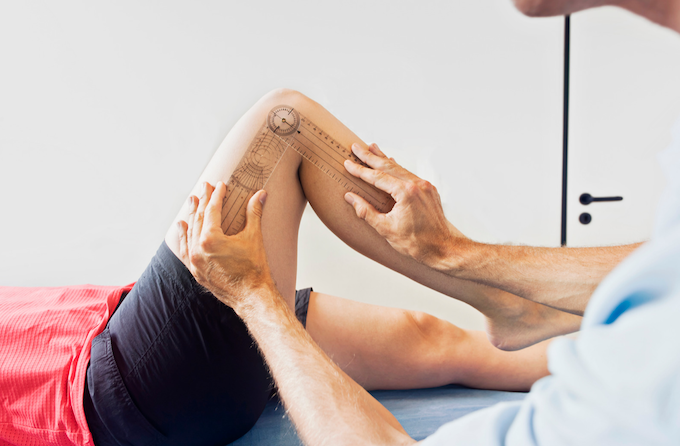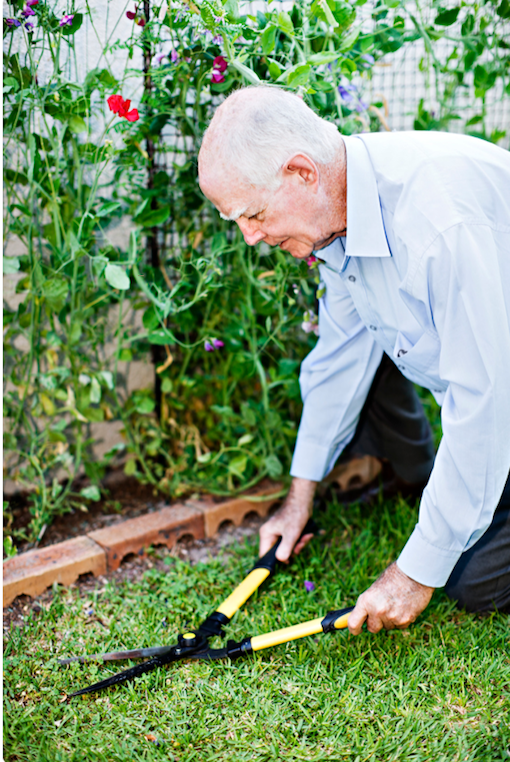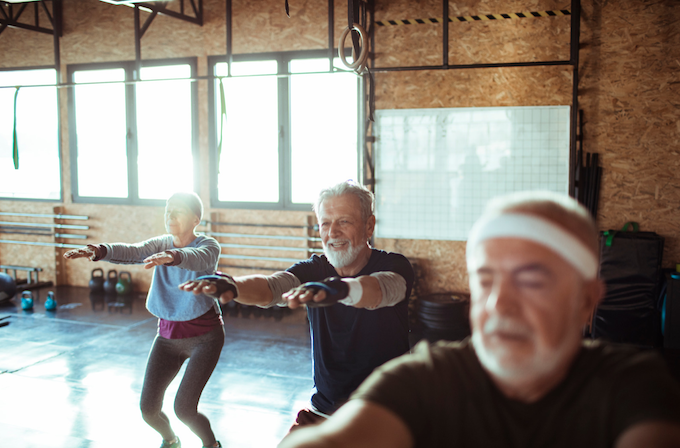For people with osteoarthritis, total knee replacements are a common and successful choice for improving quality of life.[6] A lot of people who have a knee replacement are satisfied with the outcome and can continue enjoying their daily activities.[6] One of the most important factors that leads to people being happy with their knee replacement, also called patient satisfaction, is the ability to bend the knee, also called knee flexion.[6] First I will discuss what knee flexion is and then describe what a high-flexion (HF) knee replacement is.
Knee Flexion
Knee flexion is measured in degrees with normal knee flexion ranging from 0-140/145 degrees.[2] People who are 45-69 have an average knee flexion of 138 degrees for females and 127 for males.[1] If you need a reference point, your knee is usually around 90 degrees when you are sitting in a chair. So why is this important? Most functional and daily activities depend on flexion of the knee.[6] Going up and down stairs requires 90-120 degrees of knee flexion.[6] Transferring in and out of a bathtub requires up to 135 degrees of knee flexion.[6] Kneeling, squatting and sitting cross-legged require an even greater degree of knee flexion.[6] Following a standard total knee replacement, knee flexion usually stays around 110-115 degrees.[6] This leaves people with less knee flexion than other people who are the same age and makes it difficult to do activities that require higher knee flexion such as squatting and kneeling.[6]

Image by Jan-Otto via Canva. Knee flexion is one of the most important factors that leads to patient satisfaction after a knee replacement surgery.
What is a high-flexion knee replacement?
The aim of a high-flexion (HF) knee replacement is to allow the person to achieve the maximum amount of flexion after surgery.[3] Now, we have to keep in mind that after surgery, the amount of knee flexion you can achieve is based on a lot of factors, but the most important factor is how much flexion you had before the surgery.[6] So, a HF-knee replacement is just one way to attempt to improve knee flexion. The difference between a HF-knee replacement and a standard knee replacement is the type of prosthesis that they use. A prosthesis simply is just a man made body part that surgeons use to mimic the old body part (in this instance, your knee). The description of the prosthetic they use for a HF-knee replacement is quite complex, but in general, it allows for a greater degree of knee flexion by limiting stress in the joint and keeping the prosthesis secure while at greater degrees of flexion. If you would like to read more about the details of this procedure please refer to "High-Flexion Posterior-Stabalized Total Knee Prosthesis: Is It Worth the Hype?

Image by Maridav via Canva. High-flexion knee replacements have been shown to imrpove flexion and increase quality of life as compared to a standard knee replacement.
How does a HF-knee replacement compare to a standard knee replacement?
There are mixed reviews in terms of comparing HF-knee replacement to standard knee replacements. On one hand, HF-knee replacements have been shown to improve knee flexion range of motion by 15-25 degrees compared to a standard knee replacement.[3] HF-knee replacement has also been shown to have greater improvements in general health, physical functioning and overall quality of life compared to standard knee replacement.[7] However, other research has shown that there has been no difference in overall knee flexion compared to standard knee replacement.[6] This could be due to the many factors that determine knee flexion after surgery. When comparing the survival rate (how long your knee replacement will last), HF-knee replacement and standard knee replacement last approximately 20 years with a standard knee replacement slightly outperforming the HF-knee replacement.[4]

Image by RapidEye via Canva. A high-flexion knee replacement may allow you to continue activities that require alot of knee flexion.
Is a HF-knee replacement right for me?
So, after digesting all that information in the paragraph above, you're probably wondering if a HF-knee replacement is right for you? Well, after reviewing many articles, the two most common reasons why people opt for a HF-knee replacement is because they are young and have a desire for high flexion activities.[3][6] An increasing amount of knee replacements are being performed in people who are younger than 65.[3] When you are still young and more active, people want to be able to do activities like kneeling and squatting that require high flexion, and thus choose this option. Additionally, people who require high knee flexion for social, cultural or religious activities find that standard knee replacement may be unsatisfactory, and choose HF-knee replacement to accommodate these activities.[5] If your daily activities require a lot of flexion, a HF-knee replacement may be a good choice for you.
Conclusion
One of the most important factors that leads to patient satisfaction after a total knee replacement is the ability to bend your knee backwards (knee flexion). Normal knee flexion ranges from 0-140/145 degrees with activities like kneeling and squatting requiring higher degrees of knee flexion. High-flexion (HF) knee replacements were developed to help achieve higher degrees of knee flexion. There are mixed reviews when it comes to comparing HF-knee replacements to standard knee replacements. HF-knee replacements improve knee flexion by 15-20 degrees while also improving physical functioning and overall quality of life compared to standard knee replacements. On the other hand, some research shows no difference in knee flexion between the two knee replacements. Despite this, HF-knee replacements is a common procedure and is generally performed in younger people (below 65) and in individuals who require high knee flexion for cultural, religious and social reasons.
For more information on knee replacement and knee replacement recovery you can download the Curovate App. Curovate provides a personalized physical therapy plan with video guided exercises to complete throughout each stage of the healing process, all in the comfort of your own home. If you have undergone knee replacement surgery, Curovate can help! Click the links below to download our physical therapy app for patients!
If you need further customized assistance during your surgery or injury recovery check out our Virtual Physical Therapy page to book your 1-on-1 video session with a physical therapist.
 |
 |
|---|
Other Related Blogs
- What is a Total Knee Replacement?
- What is Osteoarthritis?
- What is range of motion and why is it important following knee replacement? - ROM: Part 1
- How Can I Improve My Knee Bending and Straightening? - ROM: Part 2
- Knee replacement recovery: After knee surgery can I kneel? How do I sleep? What movements are safe and what should I avoid
- Can I kneel after a Knee Replacement?







